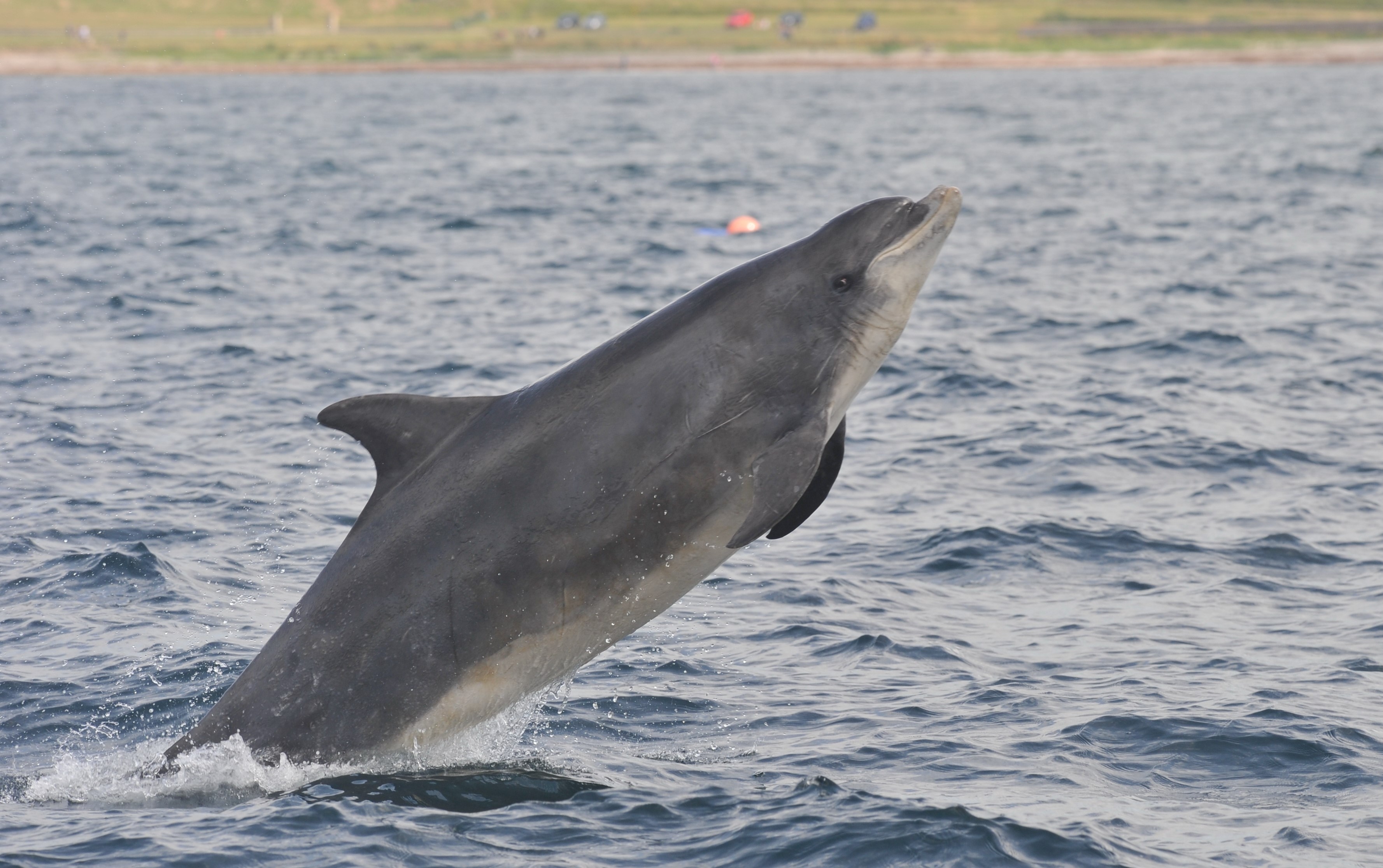- Order:Cetacea
- Suborder:Odontoceti
- Family:Delphinidae
- Genus:Tursiops
- Species:Tursiops truncatus (Montagu, 1821)
Identification
The bottlenose dolphin (Tursiops truncatus) is a robust, chunky dolphin with a well-defined (usually short and stubby) beak that is sharply demarcated from the forehead by a distinct crease. It varies in colouration from dark grey through to light grey to brown, although individuals may range in colour from all black, white (albino), to a cinnamon colour. An indistinct cape runs from the top of the melon to the dorsal fin, narrowing to a thin line behind the fin. The sides of the body are lighter than the cape and graduate laterally to a pale ventral surface which may be light grey to even pink in colouration. Individuals are commonly scarred from interactions with conspecifics, males usually being more scarred than females. The flippers are of moderate length, and pointed at the tip. The dorsal fin is falcate and located mid-back, and the tail flukes have an obvious central notch.
Travelling bottlenoses often move as a unit, diving and surfacing synchronously. Foraging dives vary in length for up to several minutes. These dolphins may be highly active, particularly when feeding or socialising. Aerial behaviour may include leaps, head-slams, nose-outs, tail-slaps, headbutting and throwing kelp or prey items into the air. Animals have also been observed riding the advancing crests of waves in rough seas.
Distribution & Habitat
Found throughout the world's oceans and seas, bottlenose dolphins are cosmopolitan in distribution, distributed from temperate and tropical waters of the Atlantic, to Pacific and Indian Oceans, as well as the Mediterranean, Black and Red Seas. In the Pacific, they range from northern Japan and southern California, to Australia and Chile. In the Atlantic they may be found from Nova Scotia and Norway to Patagonia and South Africa. They are also prevalent in the Indian Ocean, from Australia to South Africa.
Populations of the species may range from being resident within a well-defined home range, to seasonally migratory, or a combination of residency and seasonal shifts in distribution. Localised changes in distribution between seasons (as noted off Florida and Texas) may reflect changes in distribution of food sources, changes in abundance of predators or suitability of the area for breeding or raising young. Long-range movements have been observed in identifiable dolphins which have disappeared from a study area for months and then re-appeared in the study area once again. There are generally two recognised ecotypes of bottlenose dolphins: one form having a coastal distribution and the other occupying a more offshore or pelagic habitat.
Natural History & Ecology
In the UK, bottlenose dolphins can measure up to 410 cm in length. Males reach sexual maturity at lengths of 245 to 260 cm between 10 to 13 years of age. Females become sexually mature from 5 to 12 years of age and at lengths from 220 to 235 cm.
The gestation period in bottlrnose dolphins lasts approximately 12 months. New-born calves, measuring between 98 and 126 cm in length and weighing 9 to 12 kg, are produced singly, and typically remain with their mothers for 3 to 5 years. In captive born dolphins, suckling has been observed for 18 to 20 months, but evidence from wild dolphins suggests that nursing could continue well beyond the age of 3 years, possibly lasting up to 7 years in some individuals. Adult bottlenose dolphins have been observed in aggressive interactions with calves, the young dolphins sometimes being tossed into the air by the adults. Some researchers have interpreted this kind of behaviour as disciplinary behaviour but infanticide in this species is also now well-documented. Calves may swim for extended periods with adults other than their mothers. Typically, the "baby sitters" are seen playing with calves whilst the mother is hunting, often at a distance of several hundred metres away or more.
The feeding techniques used by bottlenose dolphins are diverse and complex. These may include: co-operative hunting, working in groups to herd fish in the open sea; foraging individually in the surf zone over reefs and rocky outcrops; corraling fish by rapidly spinning around a fish, encircling it to cut off its escape (known as pinwheeling); "fish-whacking" or "fish-kicking" (where the dolphin makes a tight circle around the fish, lashes its tail through the middle of the circle and launches the fish into the air); chasing fish onto mud banks or throwing individual fish on to the shore and then stranding to capture the fish; following shrimp boats and other fishing boats to get trash fish and items stirred up by the fishing gear; and even cooperating with fishermen (e.g. in Mauritania and Queensland), herding fish into nets set close to the shore. The species is extremely adaptable and opportunistic in its feeding habits, eating whatever fish is most abundant. Prey items may include invertebrates, such as hermit crabs and shellfish, to large ocean-going fish. The diet may vary between offshore and coastal dolphins, with offshore animals feeding on a greater variety of pelagic fish species and squid and coastal animals feeding more on benthic and demersal species. The Scottish bottlenose have a particular preference for salmon in their diet.
Although bottlenose dolphins appear to be non-selective in their feeding habits, the dominant fish species in their diet are known to produce specific sounds. These may include grunts, whistles or growls, which may make them more susceptible to predation. It has been suggested that bottlenose may detect and perhaps orientate their fish prey by listening for the sound they produce. Evidence indicates that this coastal delphinid may actively feed by day and by night.
Social Behaviour
The social organisation of the bottlenose dolphin is very complex. Groups sizes may range from 2 to 200 dolphins, but are most frequently between 5 and 15 individuals. School sizes tend to increase with water depth and may alter throughout the day with activity, age or sex class (females with calves, for example, tend to occur in larger schools than males). Larger groups are typically composed of smaller subgroups dispersed over several kilometres.
The composition of a school may change and fluctuate over the course of a day, but membership of a particular female band may be quite exclusive. Sexually segregated groups are common. Sub-adult (teenage) dolphins and adult males, for example, may form lasting associations among themselves, often with animals from their natal pod. The associations of the longest duration, however, are undoubtedly between female bottlenose dolphins and their calves. There are several documented cases of epimeletic care giving in dolphins which reflect this strong mother-infant bond. These include cases of individuals attending deceased calves for prolonged periods of time.
The bottlenose dolphin is a highly sociable and tactile mammal. Animals can often be seen swimming side by side, nudging one another with their snouts and rubbing against each other. Rubbing and touching may be associated with copulatory activity, but close interpersonal association need not always indicate copulatory behaviour. Such behaviours seem to occur more frequently when 2 sub-groups that have been separate for several hours rejoin each other.
The behaviour of captive and free-ranging bottlenose dolphins has been noted to be significantly influenced by a diurnal rhythm; the frequency of social interactions reaching maximum levels in the morning and declining in the late afternoon. Noisy leaps (splashing into the water) seem to be used to attract the attention of the rest of the group.
The species often associates with other cetacean families, and is commonly seen to co-occur with pilot whales, humpback dolphins, spotted dolphins and spinner dolphins. In South America, they have been observed with southern right whales, often veering from their path to join the whales. Off Hawaii, they are also known to interact with humpback whales. Rake marks and scratches on the bodies of solitary dolphins suggest that they also have regular close contact with other less well-documented cetacean species.

